Coconut trees are important to many communities and our daily lives. These trees are pest-prone, reducing output and the farmer’s income. Traditional pest control methods have environmental and health risks. Thus, eco-friendly coconut pest management methods are gaining popularity. This blog post discusses common coconut pests, traditional pest control methods, eco-friendly and sustainable strategies, benefits, and implementation. These measures may increase yields and protect farmers’ health and the environment.
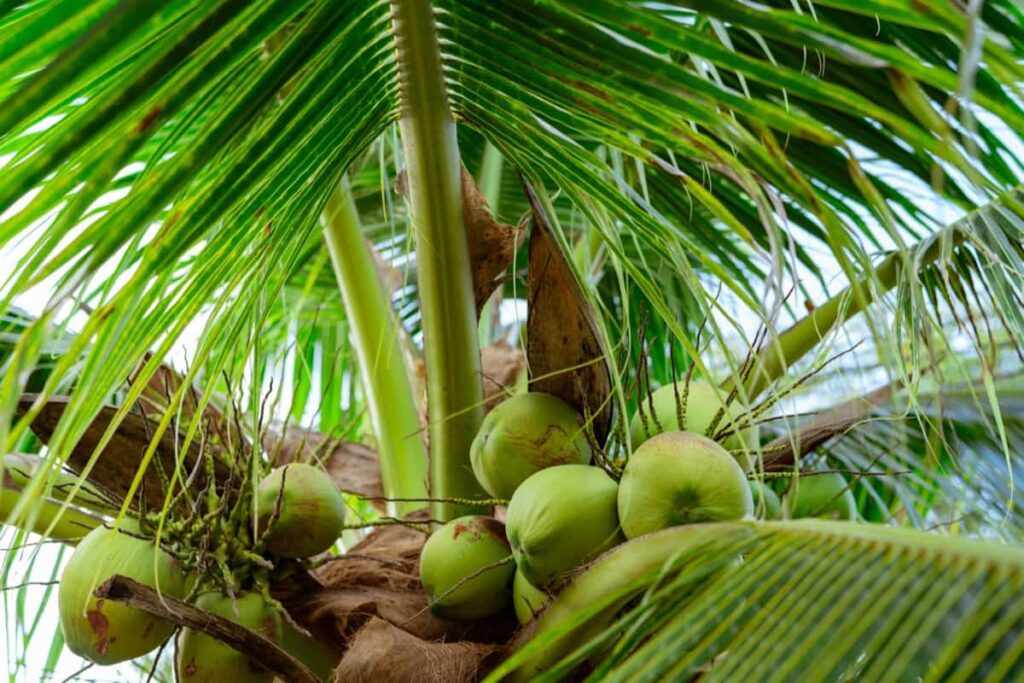
Management of Coconut Pests
What is Coconut Farming?
Coconut farming is an essential livelihood for ten million people in India, and it is considered the “tree of heaven” due to its importance in various industries. India leads in coconut production worldwide, with an annual production of 23.90 billion nuts from an area of 2.15 million hectares, with an average productivity of 9897 nuts per hectare.
The four southern states, Kerala, Tamil Nadu, Karnataka, and Andhra Pradesh, contribute over 90% of the production. By adopting scientific technologies, coconut cultivation can increase yields four-fold. Therefore, there is a considerable opportunity to improve coconut productivity by adopting scientific cultivation technologies.
Best Package and Coconut Cultivation Practices
Ideal Conditions: Coconut is a tropical plant that thrives in various climatic and soil conditions. The optimal temperature for coconut growth and yield is 25° C, with a humidity level of at least 60%. The palms can reach heights of 600m above sea level. Coconut plantations can be constructed up to a height of 1000m.
Coconut varieties are classified as tall or dwarf. The tall cultivars are West Coast Tall and East Coast Tall, while the dwarf type is smaller and has a shorter life span than the tall. Tall x Dwarf (TxD) and Dwarf x Tall (DxT) are the two most important hybrids. Hybrid combinations produce great yields under good management circumstances.
Coconut is propagated by raising seedlings from selected seednuts. Planting is often done with seedlings that are 9 to 12 months old. Seedlings with 6–8 leaves and a 10–12 cm collar girth are selected for planting when they are 9–12 months old. Coconut seedlings should be planted in well-drained soils with proper moisture supply through well-distributed rainfall or irrigation.
In case you missed it: Cauliflower Insect Pest Management: Effective Tips for Protecting Your Crop
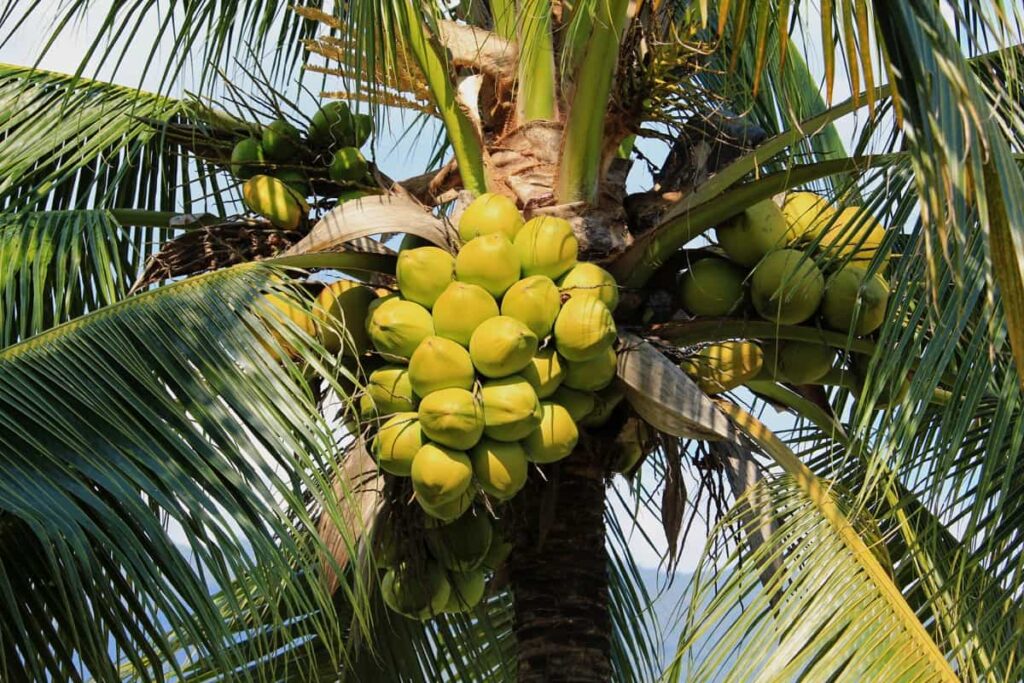
Planting coconut requires a pit of the recommended size, depending on the soil type. In sandy soils, a pit size of 0.75m x 0.75m x 0.75m is sufficient, while in laterite soils with underlying rocks, a pit size of 1.2m x 1.2m x 1.2m is recommended. The planting strategy, soil type, and other factors determine the spacing. In general, several planting strategies propose the following spacing on sandy and laterite soils:
- 7.6m triangular
- 7.6×7.6m, 8x8m, and 9×9 m
- Single: 6.5m between rows, 9m between rows.
- Double Hedge: 6.5 to 6.5m per row – 9m between rows
At the start of the southwest monsoon, seedlings can be transplanted. If irrigation is available, it is best to start planting at least a month before the monsoon so that seedlings can establish themselves before severe rains. During the summer, the transplanted seedlings should be appropriately sheltered and irrigated. Irrigate the young seedling twice a week during the dry summer for the first two years after planting.
Shade is necessary for transplanted seedlings. Regular manuring and providing fertilizers, as per the recommended schedule, can increase the yield of coconuts. Proper pest and disease management practices, including timely pruning of fronds, removal of dead fronds, and removal of inflorescences, can help in the proper growth and higher yield of coconut.
Major and Common Insect Pests of Coconut
- Rhinoceros beetle (Oryctes rhinoceros)
- Red palm weevil (Rhynchophorus ferrugineus)
- Coconut mite (Aceria guerreronis)
- Black-headed caterpillar (Opisina arenosella)
- Coconut leafminer (Promecotheca cumingii)
- Mealybugs (Planococcus minor)
- Whitefly (Aleurodicus destructor)
- Slug caterpillar (Limacodidae spp.)
- Coreid bug (Pseudotheraptus devastans)
Common Coconut Pests Symptoms and Their Characteristics
- The Rhinoceros beetle, Oryctes rhinoceros Linn, is a widespread pest that causes over 20% damage to juvenile palms by boring into the young palms’ collar region, resulting in a dead heart, twisted spindle with elephant-tusk-like symptoms, and perverted leaflets.
- Symptoms and characteristics: The beetle also bores into the unopened fronds/spindle region/spear leaf/spathes/nuts of adult palms. The characteristic symptom of the affected fronds is the V-shaped diamond-shaped cuts upon unfurling and chewed-up fibers from the feeding site. The beetles breed on decaying organic debris, farmyard manure, dead coconut stumps, logs, and compost and are mostly seen from February to April, with a life cycle of six months. Attack by rhinoceros beetle leads to infections by bud rot and leaf rot.
- The red palm weevil, Rhynchophorus ferrugineus Olivier, is a fatal enemy of coconut palm. Young palms under 20 years of age succumb to severe damage when infested by this pest.
- Symptoms and characteristics: Adult beetles lay eggs in the injured parts of the trunk or collar region, and grubs emerge after 3 to 4 days and enter into the wounded portion of the trunk or collar region. Wilting of the central spindle chewed fibers, cocoons in the trunk, and holes in the trunk with brown fluid oozing out are the important symptoms of a red palm weevil attack.
- The grubs of red palm weevil molt into ten different instars in a period of 36-78 days and further undergo pupation for a period of 22 to 25 days. Afterward, the adult weevil emerges. Adult weevils have a lifespan of 60 to 70 days and can multiply abundantly in young coconut plantations, causing losses of 1-3 percent.
In case you missed it: Effective Strategies for Managing Insect Pests in Cabbage: A Guide for Farmers and Gardeners
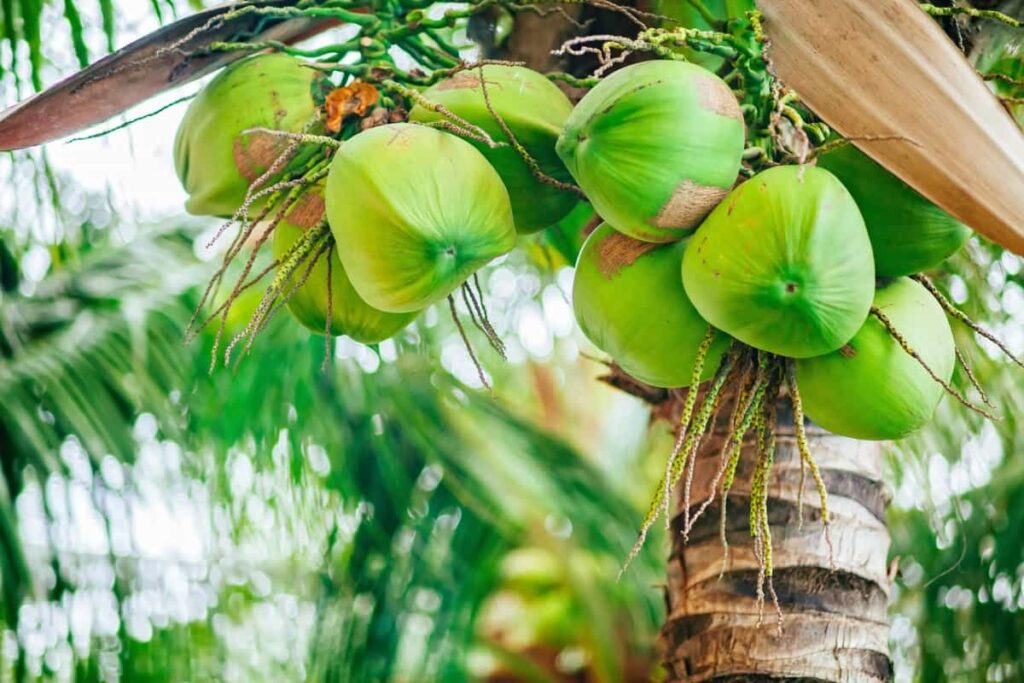
- Coconut eriophyid mite, Aceria guerreronis Keifer, is another invasive pest that infests by sucking sap from the soft meristematic tissues beneath the tepals on buttons.
- Symptoms and characteristics: The damage caused affects the quality of the husk, and de-husking becomes difficult. Leaf-eating caterpillar Opisina arenosella Wlk. is another serious pest of coconut that lives on the undersurface of leaflets inside silken galleries and feeds voraciously on the chlorophyll-containing functional tissues. This adversely affects the health of the palm by reducing the photosynthetic area and results in yield reduction.
- Leaf-eating caterpillar/Black-headed caterpillar: Opisina arenosella Wlk. is a leaf-eating caterpillar that is a serious pest of coconut, particularly in coastal and backwater tracts.
- Symptoms and characteristics: The caterpillars create silken galleries on the undersides of leaflets and feed voraciously on chlorophyll-containing tissues, reducing the photosynthetic area and yield. Infestations are most severe from February to May, and older leaves may become dead and brown, with only a few younger leaves remaining green. Severe infestations can cause a significant reduction in nut yield and canopy growth, resulting in a scorched appearance across the plantation.
- Rugose spiralling whitefly (Aleurodicus rugioperculatus) is an invasive pest of Neotropical origin that feeds and breeds on the underside of coconut palm leaves, producing abundant honeydew.
- Symptoms and characteristics: The honeydew attracts black-colored fungi called sooty molds, which grow on the upper surface of coconut leaves and impair photosynthesis. Sooty molds are a characteristic symptom of feeding damage by RSW, and their presence can ascertain the presence of RSW in the palm system. While RSW may not cause significant economic damage, it is highly polyphagous and poses a biosecurity risk to other crops.
- The white grub, Leucopholis coneophora Burm, is a soil-dwelling pest that causes significant damage to coconut trees and other crops such as tapioca, colocasia, and sweet potato.
- Symptoms and characteristics: The grubs feed on tender roots, tunneling into the collar region and causing the drying up of spear leaves, yellowing of outer leaves, and ultimately, the death of the seedling. In mature coconut plantations, infestations lead to yellowing of leaves, premature nut fall, delayed flowering, growth retardation, and reduced yield. Adult beetles emerge from the soil in June, briefly after sunset.
- Coreid bug (Paradasynus rostratus) is a pest primarily affecting coconut trees in Kerala’s coastal and highland regions.
- Symptoms and characteristics: It feeds on the meristematic regions of tender buttons, causing necrotic lesions and spindle-shaped depressions. The feeding punctures on female flowers result in barren nuts and the shedding of infested buttons and tender nuts. The bug’s emergence is associated with increased population densities from environmental changes. The peak population occurs during October-December. Furrows, crinkles on husks, and gummosis are common symptoms of infestation. The bug also infests tamarind, cashew, cocoa, and guava.
- Slug caterpillars, including Contheyla rotunda, Parasa lepida, and Darna nararia, are pests that feed on the undersurface of coconut leaflets, leaving a glistening appearance on the feeding area.
- Symptoms and characteristics: The feeding areas develop black halo-like markings that later merge into bigger lesions. The grown-up caterpillars feed voraciously on the leaf tissues, leaving only the midribs, leading to the leaves’ scorched/burnt appearance. In severe infestations, all functional leaves dry up, leaving only the inner leaves. This results in reduced photosynthetic efficiency, premature drooping of leaves, and shedding of nuts, leading to a drastic reduction in nut yield.
In case you missed it: A Profitable Comprehensive Aloe Vera Farming Business Plan
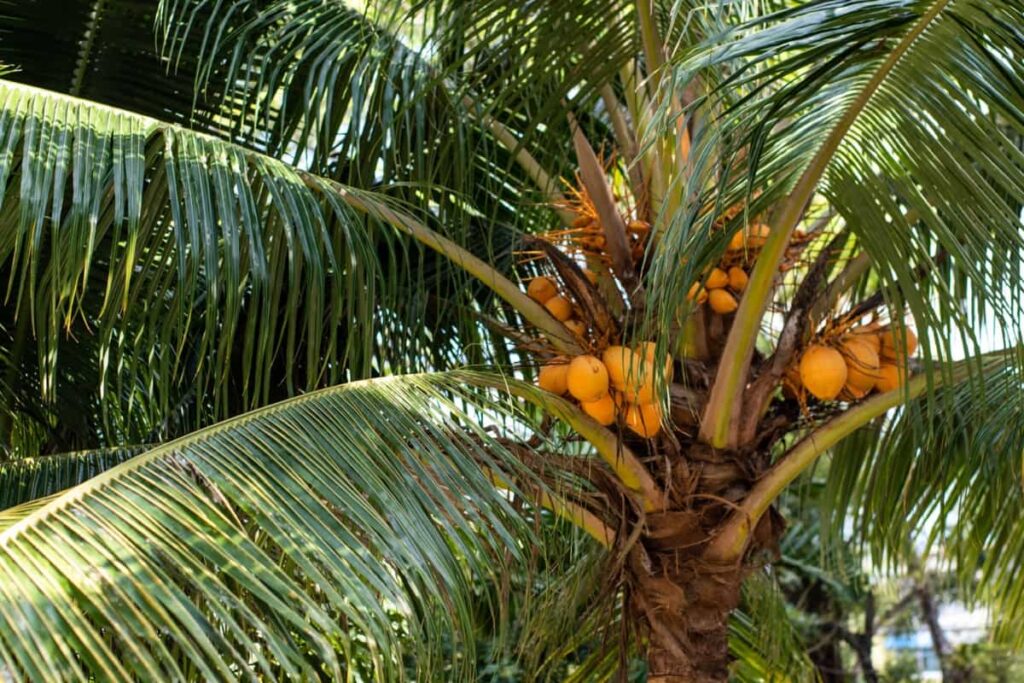
Traditional Methods of Pest Control and Their Limitations
- Biological control: use of natural enemies like predators, parasites, and pathogens.
- Limitations: effectiveness depends on natural conditions, is time-consuming, and requires specific knowledge and skills.
- Mechanical control uses physical barriers or traps to prevent pest entry or capture.
- Limitations: limited effectiveness, time-consuming, and requires frequent maintenance.
- Cultural control: farming practices like crop rotation, planting resistant varieties, and maintaining healthy soil.
- Limitations: effectiveness varies with pests and crops, may require additional resources, and results may take time.
- Chemical control: use of pesticides to kill or repel pests.
- Limitations: may harm non-target organisms, contribute to pesticide resistance and require frequent application.
Eco-Friendly and Sustainable Strategies for Managing Coconut Pests
Rhinoceros Beetle
Effective and sustainable management of the Rhinoceros beetle involves measures such as maintaining farm sanitation, monitoring palm damage, using GI hooks for mechanical extraction, and applying prophylactic measures such as neem cake and naphthalene balls. Sachets containing chlorantraniliprole or botanical cake can also be used during the monsoon phase.
The use of Oryctes rhinoceros nudivirus and green muscardine fungus can help control the pest population. In addition, PVC pheromone traps and nanomatrix field delivery can be used for pest suppression. Incorporating Clerodendron infortunatum Linn. weed plant biomass in compost pits can also help manage the pest.
Red Palm Weevil
Effective management of red palm weevil involves avoiding injury to palms, leaving petioles of a length of 120 cm on the trunk, removing and burning infested palms, filling prophylactic leaf axils, applying 0.02% imidacloprid 17.8 SL, 0.013% spinosad 2.5 SC, or 0.04% indoxacarb 14.5 EC using spot application.
Additionally, installing traps with aggregation pheromone, using commercially available Ferrolure+, and intercropping in coconut gardens can help reduce the incidence of red palm weevil attacks. A single trap per hectare was ideal, filled with 150 g banana, 2 g yeast, and 2 g fipronil in 1 liter of water.
In case you missed it: The Ultimate Guide to Crafting a Profitable Cardamom Farming Business Plan and Maximizing Production
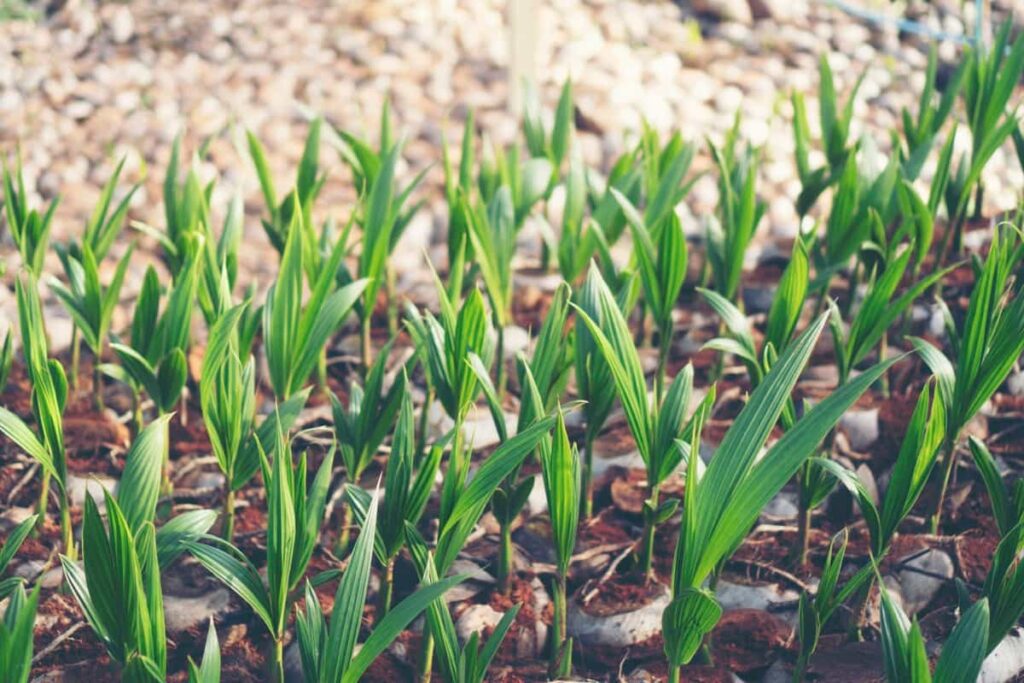
Coconut Eriophyid Mites
Coconut eriophyid mites, practices such as removing dried spathes, inflorescence parts, and fallen nuts, root feeding with azadirachtin, and spraying with neem oil-garlic-soap mixture are recommended. Additionally, neem formulations containing 1% azadirachtin can be sprayed during specific months, and neem cake can be applied with fertilizers and cowdung or compost.
Palm oil and sulphur emulsion can be sprayed on pollinated coconut bunches, and Kalpa Haritha, a tall selection from Kulasekaram green dwarf, is suggested for use in endemic zones. Crown cleaning and intercropping with green manure crops also benefit pest management.
Leaf-eating Caterpillars
Leaf-eating caterpillars in coconut, cutting and burning infested leaves, improving soil and palm health with fertilizers and organic manures, and avoiding using chemicals as there are natural enemies that can control the pest. Augmentative release of specific parasitoids like Goniozus nephantidis, Bracon brevicornis, Elasmus nephantidis, and Brachymeria nosatoi can be effective in sustainable pest management. Conditioning parasitoids on larval frass before release enhances their effectiveness.
Rugose Spiraling Whitefly
Rugose spiraling whitefly and tall coconut varieties are preferred, and insecticides should be avoided to protect the Encarsia guadeloupae parasitoid. Instead, yellow sticky traps and water jet sprays can be used, and good nutrition and watering should be provided to improve palm health. The sooty mold scavenger beetle Leiochrinusnilgirianus can also help control the whitefly, and habitat diversification with intercrops is recommended.
Coreid Bugs
Coreid bugs in coconut, crown cleaning, and azadirachtin spray are effective measures. Two rounds of azadirachtin spray during May-June and September-October are recommended. The weaver ant is an efficient predator of coreid bugs, while Chrysochalcissa oviceps and Gryon homeoceri are identified as potential egg parasitoids. In a severe outbreak, lambda-cyhalothrin spray on pollinated bunches is suggested.
Slug Caterpillars Eco-Friendly and Sustainable Management
For slug caterpillars, light traps can be established to monitor and reduce the population of moths. The larvae can be parasitized by natural enemies such as Eurytoma tatipakensis Kur., Euplectromorpha natadae Kur., and Secodes narariae Kur. Additionally, good nutrition and irrigation are needed for infested palms to recover, which can take up to 20-24 months.
Benefits of Eco-Friendly and Sustainable Strategies
- Eco-friendly and sustainable pest management strategies help reduce the negative impact of chemical pesticides on the environment and human health.
- These strategies promote using natural enemies, such as predators and parasitoids, to control pest populations and maintain a healthy balance in the ecosystem.
- They also encourage using organic fertilizers and cultural practices, such as crop rotation and intercropping, to promote plant growth and reduce pest incidence.
- Implementing eco-friendly and sustainable pest management strategies can increase crop production and improve overall plant health, leading to better economic outcomes for farmers.
- These strategies are also in line with global efforts toward sustainable development and reducing the carbon footprint of agricultural practices.
In case you missed it: From Seed Selection to Successful Business: Crafting a Comprehensive Avocado Farming Business Plan
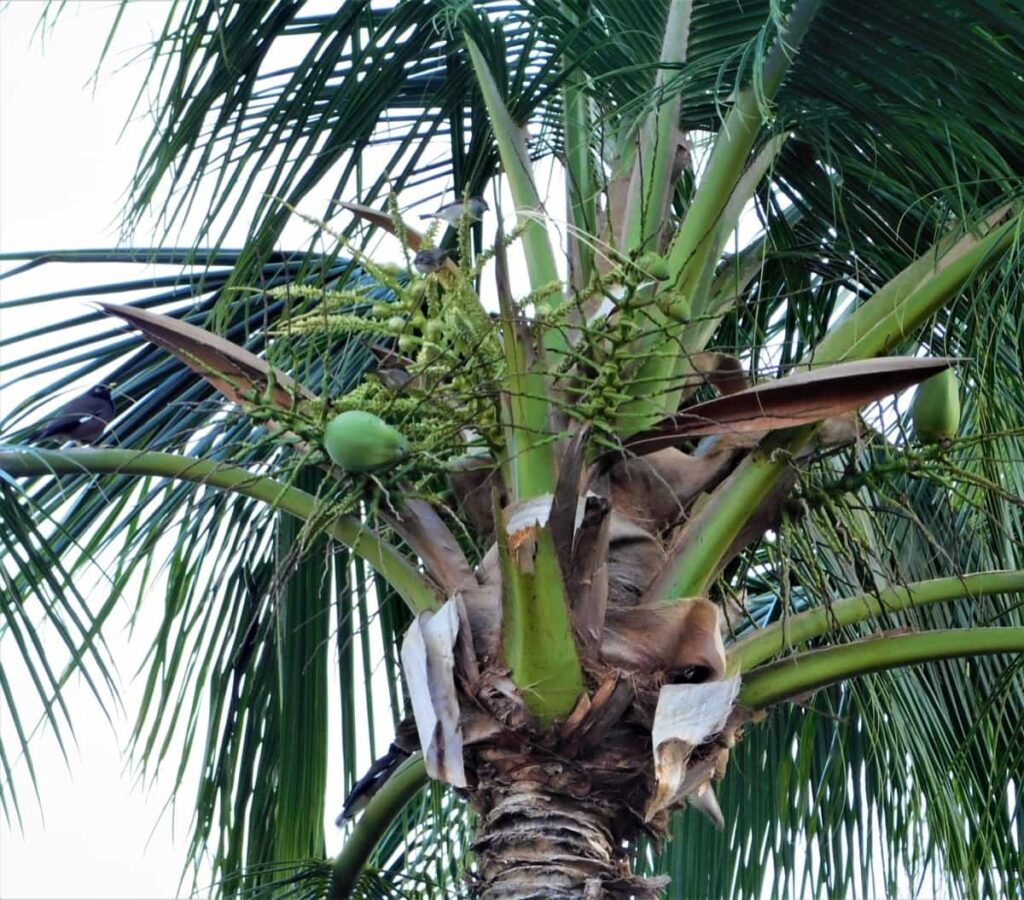
Conclusion
Eco-friendly and sustainable strategies for managing coconut pests provide long-term benefits by reducing harmful chemicals, preserving natural predators, and promoting a healthy agroecosystem. Implementing these strategies can increase productivity and profitability for coconut farmers while safeguarding the environment.
- How to Raise Pigs in Your Own Backyard: A Comprehensive Guide
- Budget Friendly Sheep Shed Ideas: Cheap and Low-Cost Tips
- How Much Do Cattle Farmers Make: Revenue Streams in Cattle Farming
- Management Pests and Diseases in Your Cotton Field
- Sheep Farming Business Plan for Beginners
- Aquaponic Farming at Home: A Step-By-Step Guide
- Profitable Village Farming Business Ideas in 2024
- High-Yield Aquaculture: Fast-Growing Fish for Farming
- Effective Fish Pond Construction Techniques for Beginners
- Irrigation and Water Management in Pineapple Farming
- Blossom to Harvest: Mastering Flowering and Pollination in Papaya Farming
- Pig Fattening Essentials: From Selection to Sale for Beginners
- Raising Wagyu Cattle: A Complete Guide for Premium Beef Production
- Soil Types and Their Water Holding Capacity
- Optimizing Irrigation Schedules for Coconut Groves for Enhanced Yield
- Espresso Your Garden: Coffee Grounds for Healthier Acid-Loving Plants
- The Best Soil Mix for Snake Plants: How to Mix Your Own Snake Plant Soil
- Green Thumb Success: Expert Tips for Cultivating Greenhouse Beans All Year Round
- Bloom All Year Round: The Ultimate Guide to Indoor Hyacinth Care
- Eco-Friendly Gardening: How to Make Liquid Fertilizer from Kitchen Waste
- Ultimate Guide to Grow Anise in Pots: Explore Seed Propagation to Harvesting
- Guide to Raising Chester White Pigs: Discover Breed Facts to Growth Management
- Mastering the Elegance: The Ultimate Guide to Weeping Cherry Tree Care, Planting, and Maintenance
- Ultimate Guide to Planting Garlic in Grow Bags: Growing Strategies for Beginners
- How to Fix Spider Plant Leaf-Related Problems: Natural and Organic Remedies
- 10 Reasons Why Your Tulsi Plant is Shedding Leaves: Home Remedies and Solutions
- Optimizing Growth and Yield: The Advantages of Palm Bunch Ash Fertilizer
- Utilizing Neem Oil Extract as a Natural Pesticide for Hydrangea
- From Soil to Harvest: Various Ways in Which Farmers Can Use AI Tools
- Steps to Encourage and Induce Citrus Flowers: A Comprehensive Guide
- How to Fix Snake Plant Leaf-Related Issues: Natural and Organic Remedies
- Transform Your Garden into a Fragrant Oasis with Raat Ki Rani (Night Blooming Jasmine)
- Discover the Ideal Chicken Breeds for Philippine Farms
- How to Create a Poultry Egg Farm Business Plan for Profits
- Grow Lemon Cucumbers Like a Pro: Insider Techniques for Bountiful Yields
- Ultimate Guide to Caring for Your Pink Princess Philodendron: Tips for Thriving Variegation
